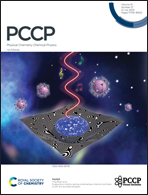Benchmarking ionization potentials using the simple pCCD model†
Abstract
The electron-detachment energy is measured by the ionization potential (IP). As a result, it is a fundamental, observable and important molecular electronic signature in photoelectron spectroscopy. A precise theoretical prediction of electron-detachment energies or ionization potentials is essential for organic optoelectronic systems like transistors, solar cells, or light-emitting diodes. In this work, we benchmark the performance of the recently presented IP variant of the equation-of-motion pair coupled cluster doubles (IP-EOM-pCCD) model to determine IPs. Specifically, the predicted ionization energies are compared to experimental results and higher-order coupled cluster theories based on statistically assessing 201 electron-detached states of 41 organic molecules for three different molecular orbital basis sets and two sets of particle–hole operators. While IP-EOM-pCCD features a reasonable spread and skewness of ionization energies, its mean error and standard deviation differ by up to 1.5 eV from reference data. Our study, thus, highlights the importance of dynamical correlation to reliably predict IPs from a pCCD reference function in small organic molecules.



 Please wait while we load your content...
Please wait while we load your content...